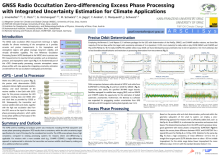GNSS Radio Occultation Zero-differencing Excess Phase Processing with Integrated Uncertainty Estimation for Climate Applications
Josef
Innerkofler
Wegener Center for Climate and Global Change (WEGC) and Institute for Geophysics, Astrophysics and Meteorology/Institute of Physics, University of Graz, Graz, Austria
Poster
The GNSS Radio Occultation (RO) measurement technique is highly valuable for climate monitoring of the atmosphere as it provides accurate and precise measurements in the troposphere and stratosphere regions with global coverage, long-term stability, and virtually all-weather capability. The new Reference Occultation Processing System (rOPS) developed at the WEGC aims to process raw RO measurements into essential climate variables, such as temperature, pressure, and tropospheric water vapor. As part of this rOPS climate-quality processing system, accurate atmospheric excess phase profiles with new approaches integrating uncertainty propagation are derived from the raw occultation tracking data and orbit data.
In order to enable high accuracy of the excess phase profiles, highly accurate orbit positions and velocities as well as clock estimates of the GNSS transmitter satellites and RO receiver satellites in low Earth orbit (LEO) need to be determined. Employing Bernese 5.2 and Napeos 3.3.1 software packages for the LEO orbit determination of the MetOp, GRACE, and CHAMP satellite missions, we achieved robust LEO orbit uncertainty estimates of about 5 cm (position) / 0.05 mm/s (velocity) for daily orbits in July 2008 (GRACE and CHAMP) and May 2013 (MetOp-A/-B), including estimates of systematic uncertainty bounds and of propagated random uncertainties. For daily COSMIC RO satellite orbits in July 2008, we found decreased accuracy estimates near 20 cm (position) / 0.2 mm/s (velocity), due to less favorable attitude behavior and restrictions in processing observations from two antennas.
The careful evaluation and quality control of the position, velocity, and clock accuracies of the daily LEO and GNSS orbits assure smallest achievable uncertainties in the excess phase processing. We focused initially on a zero-differencing approach to eliminate transmitter and receiver clock biases. The obtained excess phase profiles are compared to excess phase profiles provided by UCAR and EUMETSAT. We find high consistency with differences at millimetric level in the upper stratosphere and mesosphere for the comparison of the excess phases between WEGC and EUMETSAT for MetOp. This aligns with the expected differences, as similar processing strategies, employing zero-differencing, are used by both processing centers. The differences between WEGC and UCAR excess phases are somewhat larger, which is in line with expectation since there are more differences in the processing strategies between these centers. Finally, the status of ongoing single-differencing comparison activities of the centers is addressed.
In order to enable high accuracy of the excess phase profiles, highly accurate orbit positions and velocities as well as clock estimates of the GNSS transmitter satellites and RO receiver satellites in low Earth orbit (LEO) need to be determined. Employing Bernese 5.2 and Napeos 3.3.1 software packages for the LEO orbit determination of the MetOp, GRACE, and CHAMP satellite missions, we achieved robust LEO orbit uncertainty estimates of about 5 cm (position) / 0.05 mm/s (velocity) for daily orbits in July 2008 (GRACE and CHAMP) and May 2013 (MetOp-A/-B), including estimates of systematic uncertainty bounds and of propagated random uncertainties. For daily COSMIC RO satellite orbits in July 2008, we found decreased accuracy estimates near 20 cm (position) / 0.2 mm/s (velocity), due to less favorable attitude behavior and restrictions in processing observations from two antennas.
The careful evaluation and quality control of the position, velocity, and clock accuracies of the daily LEO and GNSS orbits assure smallest achievable uncertainties in the excess phase processing. We focused initially on a zero-differencing approach to eliminate transmitter and receiver clock biases. The obtained excess phase profiles are compared to excess phase profiles provided by UCAR and EUMETSAT. We find high consistency with differences at millimetric level in the upper stratosphere and mesosphere for the comparison of the excess phases between WEGC and EUMETSAT for MetOp. This aligns with the expected differences, as similar processing strategies, employing zero-differencing, are used by both processing centers. The differences between WEGC and UCAR excess phases are somewhat larger, which is in line with expectation since there are more differences in the processing strategies between these centers. Finally, the status of ongoing single-differencing comparison activities of the centers is addressed.

Poster PDF
Abstract file